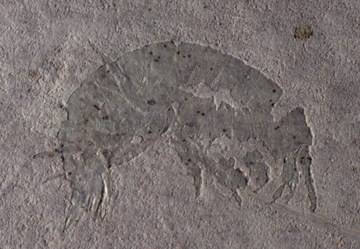Abstract
Amphipods are extremely diverse malacostracan crustaceans that have conquered many environments from oceanic abysses to the terrestrial realm. Despite their impressive modern diversity and abundance, they are particularly rare in the fossil record. Herein, we describe the exceptionally preserved Gammaroidorum yooling sp. nov. from the Late Neogene of Xiaobai Formation near Pandao village, Shanxi, China. Due to the limitation of the preservation, namely the non-preservation of setae, we could not establish a precise generic assignment, so used the collective group Gammaroidorum Jarzembowski, Chény, Fang & Wang, 2020. Although there are still doubts on the precise placement of this new species within amphipods, these fossils are important since they represent the first known fossil occurrence of an amphipod in China. Besides, these fossils have an unusual preservation, being almost transparent in most cases, and being most easily seen by reflecting light on the fossil.
References
Ahyong, S.T., Lowry, J.K., Alonso, M., Bamber, R.N., Boxshall, G.A., Castro, P., Gerken, S., Karaman, G., Goy, J.W., Jones D.S., Meland, K., Rogers, D.C. & Svavarsson J. (2011) Subphylum Crustacea Brünnich, 1772.—In: Zhang, Z.Q. (Ed.), Animal biodiversity: an outline of higher-level classification and survey of taxonomic richness. Zootaxa, 3148 (1), 165–191.
https://doi.org/10.11646/zootaxa.3148.1.33
Bellan-Santini, D. (2015) Order Amphipoda Latreille, 1816. In: Vaupel Klein, J.C. von, Charmantier-Daures, M. & Schram, F.R. (Eds), Treatise on zoology—anatomy, taxonomy, biology. The Crustacea revised and updated, as well as extended from the Traité de Zoologie, Volume 5, pp. 93–248.
https://doi.org/10.1163/9789004232518_006
Calman, W.T. (1904) On the classification of the Crustacea Malacostraca. Annals and Magazine of Natural History, (7) 13, 144–158.
https://doi.org/10.1080/00222930408562451
Chapman, J.W. (2007) Chapter 39: Amphipoda. In: Carlton, J.T. (Ed.), The Light and Smith manual: Intertidal invertebrates from Central California to Oregon. University of California Press, Oakland, pp. 545–618.
Fabricius, J.C. (1775) Systema entomologiae, sistens insectorum classes, ordines, genera, species, adiectis synonymis, locis, descriptionibus, observationibus. Libraria Kortii, Flensburgi et Lipsiae, 1–832 [In Latin].
https://doi.org/10.5962/bhl.title.36510
Hegna, T.A., Lazo-Wasem, E.A., de Lourdes Serrano-Sánchez, M., Barragán, R. & Vega, F.J. (2020) A new fossil talitrid amphipod from the lower early Miocene Chiapas amber. Journal of South American Earth Sciences, 98, 102462.
https://doi.org/10.1016/j.jsames.2019.102462
Hou, Z., Sket, B., Fišer, C. & Li, S. (2011) Eocene habitat shift from saline to freshwater promoted Tethyan amphipod diversification. Proceedings of the National Academy of Sciences of the USA, 108 (35), 14533–14538.
https://doi.org/10.1073/pnas.1104636108
ICZN (1999) International Code of Zoological Nomenclature. Fourth Edition. International Trust for Zoological Nomenclature. Natural Museum, London, v–xxix, + 1–306.
Jarzembowski, E.A., Chény, C., Fang, Y. & Wang, B. (2020) First Mesozoic amphipod crustacean from the Lower Cretaceous of SE England. Cretaceous Research, 112, 104429.
https://doi.org/10.1016/j.cretres.2020.104429
Latreille, P.A. (1802) Histoire naturelle, générale et particulière des crustacés et des insectes. Tome 3. F. Dufart, Paris, 1–467 [In French].
Latreille, P.A. (1816) Les Crustacés, les Arachnides, les Insectes. In: Cuvier, G. (Ed.), Le Règne animal distribué d’après son organisation, pour servir de base à l’histoire naturelle des animaux et d’introduction à l’anatomie comparée, Tome III. Déterville, Paris, 1–653 [In French].
Lowry, J.K. & Myers, A.A. (2013) A phylogeny and classification of the Senticaudata subord. nov. Crustacea: Amphipoda). Zootaxa, 3610 (1), 1–80.
https://doi.org/10.11646/zootaxa.3610.1.1
Shanxi Provincial Bureau of Geology and Mineral Resources (1997) Lithologic Stratigraphy of Shanxi Province. China University of Geosciences Press, Wuhan, 353 pp [In Chinese].
Wei, R.Z., Zhuang, Q.T., Yan, J.Y., Wei, Y.F., Du, Y.W. & Fan, J.H. (2020) Late Cenozoic stratigraphic division and sedimentary environment of Jinzhong Basin in Shanxi Province, and its climate and lake evolution since the pre-Qin period. Geology in China [In Chinese].
http://kns.cnki.net/kcms/detail/11.1167.P.20200417.1116.002.html
Zhu, D.G., Meng, X.G., Shao, Z.G., Lei, W.Z., Wang, J., Han, J.E., Yu, J., Lv, R.P. & Wang, Y. (2008) Ages of Neogene strata in the Baode-Jingle area, Shanxi, China. Geological Bulletin of China, 27 (4), 510–516.


